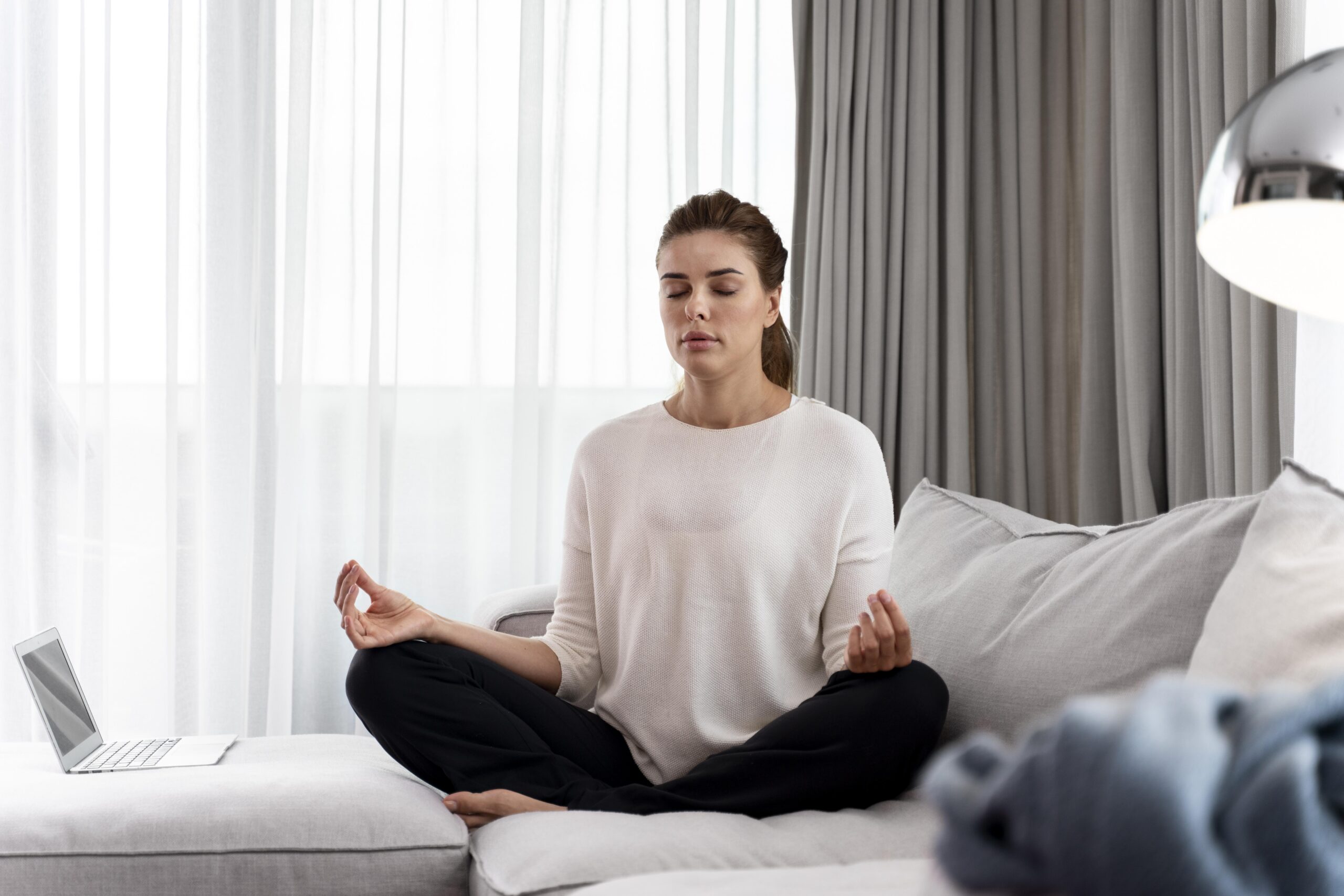Discovering a peaceful moment in this busy environment could be like discovering a precious diamond. When life throws you a curveball, a guide to meditation—a practice that blends mental and physical exertion—may help you rediscover serenity. This method’s central tenet is to unlock inner peace and strength: your guide to meditation, which is simply the act of being present in the moment. It also offers a few simple exercises.
We will discover the many ways in which a guide to meditation can help us relax and unwind as we go along. Simple actions towards becoming a more composed version of oneself are more important than complex procedures.
Come along as we explore the wonders that arise from the union of physical fitness and guide to meditation for beginners. Get ready to step into a realm where the rhythm of your breath brings you a sense of calm and serenity.
Read More: Importance of a Balanced Diet
What is Meditation?
Meditation is one kind of exercise and movement that promotes mental tranquillity. Our bodies benefit from exercise, but we also need to be extremely aware of every action and sensation that takes place.
Imagine meandering around a beautiful garden. To be completely present and aware of your environment, you have to experience every sight, sound, and sensation of every step you take. Similar to this, meditation combines fundamental motions with a full awareness of our bodies.
One of the good goals of the meditation is inner serenity. Inner tranquillity refers to the ability to maintain inner peace even in hectic or noisy environments.
It has nothing to do with striving for perfection or completing challenging tasks. It means acknowledging our inner sensations and behaving in a way that makes us happy. Therefore, mindful movement can be viewed as a tranquil voyage—a manner of being and acting that brings happiness and tranquillity into our everyday existence.
Read More: Benefits Of Coffee
How to Use Medication To Find Inner Peace?
Finding inner peace through consistent practice is like unearthing a hidden gem. When we speak of being at peace within, we mean that we have a mental state that does not fluctuate no matter how chaotic life gets. Regular physical activity is the key to releasing this cash.
Warm up your muscles by walking or stretching before you attempt any strenuous activity. Like moving your body in sync with the beat of music, finding inner calm is a process that gets easier as you keep dancing. We don’t simply mean that you’ll bulk up and run faster; we mean that you might experience a heightened sense of oneness with your inner being as a result of exercising.
Intense and mindful exercise tones our body and improves mental clarity. It appears that there are two sweets! After working out, we may feel peaceful and at ease, almost like we’ve had a mental embrace.
Why Should I Do Exercise Along With Meditation?
When you do exercise and meditate together, you get a full picture of your health. Meditation improves mental clarity, emotional stability, and inner peace, while exercise improves physical health by making you stronger, more flexible, and better at running your heart rate. They are good for the body and mind because they lower stress, raise happiness, and make life better in general. With this method, which encourages balance and community, people are given the tools they need to live better, happy lives with more energy and inner peace.
10 Exercise and Meditation For Inner Peace
Mindful Walking
Walking mindfully entails focusing on every step, your feet’s feelings, and your body’s movement. It’s a kind of guide to meditation that promotes being totally present in the here and now, which may assist to ease tension and quiet the mind.
Deep Breathing Exercises
During deep breathing exercises, slow, purposeful breaths are taken, with the goal of fully filling the lungs and then entirely expelling. By triggering the body’s relaxation response, this technique lessens anxiety and fosters a sensation of peace.
Progressive Muscle Relaxation
The goal of progressive muscle relaxation is to slowly tighten and relax different groups of muscles in the body. Not only does this method help release physical tightness, it may also help reduce worry and promote relaxing.
Yoga for Stress Relief
Yoga combines physical postures, breathing techniques, and meditation to promote relaxation and reduce stress. Consistent yoga practice may improve your strength, flexibility, and mental well-being. It may thus be a helpful technique for achieving inner serenity.
Tai Chi for Balance
Tai Chi is a mild form of martial arts that is known for its slow, flowing movements and deep breathing. Because it improves balance, rhythm, and mental focus, it is good for both physical and mental health.
Read More: Healthy Body Fat Percentage
Guided Meditation for Inner Peace
In order to practise guided meditation, you may either listen to a recording that leads you through a meditation exercise or follow the instructions of a qualified expert. These gatherings are often about unwinding, reflecting, and discovering inner serenity.
Gratitude Journaling
You may improve your mental well-being and perspective on life by keeping a thankfulness journal where you record the things you are thankful for each day. You may better concentrate on the here and now by listing your blessings rather than the problems that are stressing you out.
Spending Time in Nature
Time spent in nature has been shown to reduce stress and make people feel calm and healthy. Being in nature, whether it’s through a walk in the park, a hike through the woods, or just sitting by a body of water, can be very good for your soul.
Mindful Movement
Whether it’s yoga or simple stretching, mindful movement practices are all about moving the body with purpose and awareness. You may feel more at ease, more flexible, and more at peace with yourself by engaging in these activities.
Mantra Meditation for Focus
Using a word, phrase, or sound (a mantra) out loud or in silence may help focus the mind and create a deep state of rest during mantra meditation. This exercise might help you feel calmer, clearer, and less distracted.
Benefits Of Exercise and meditation
The benefits of exercise and guide to meditation are:
Easing Pressure
Endorphins are hormones that make you feel good, and they are released when you exercise. You can psychologically de-stress by practising mindfulness practices like deep breathing and meditation. They have a calming effect and are like having a superhero when used together.
Being Familiar with Your Body
Incorporating meditation into your exercise regimen may help you tune in to your body on a deeper level. This is analogous to embracing your bodily sensations of emotion. You become more conscious of your body’s many parts, have better balance, and are more agile.
Raising Productivity
Meditation enhances focus, and physical activity boosts cognitive capacity. Your decision-making skills, mental clarity, and situational awareness will all improve.
Revitalising Nap Time
Do some yoga, go for a run, or meditate to relax. Basically, it’s the same as telling your brain to shut up and do nothing. A well-rested body and mind are better able to face the challenges of the next day.
It seems like you’re putting together a superhero squad when you include exercise and a guide to meditation in your daily regimen. In addition to improving your physical and mental health, it also fosters inner serenity and harmony. Being physically or intellectually gifted is less crucial than becoming a personal superhero.
Combining meditation with physical exercise is like helming a superhero film of your own making. Workout after exercise will hasten your already impressive journey to better health and fitness.
Read More: Sleep Syncing
How to Incorporate Meditation into Your Daily Routine
It is of utmost importance to add exercise into your daily routine here are some of the ways to do it:
- Finding Your Perfect Time and Space
Choose a quiet time and location where you may unwind without being disturbed. Choose a location that is simple and conducive to relaxation, whether it’s early in the morning in a peaceful area of your home or during a break at work.
- Starting Small: Setting Realistic Goals
Start by meditating for short amounts of time. As you get used to it, make the times longer. Setting realistic goals keeps you from getting too stressed out and helps you form a habit that will last.
- The Breath is Your Anchor: Techniques for Beginners
Start by meditating for short amounts of time. As you get used to it, make the times longer. Setting realistic goals keeps you from getting too stressed out and helps you form a habit that will last.
- Taming the Wandering Mind: What to Do When Thoughts Arise
Understand and accept that while you focus, you will have thoughts. Instead of trying to hide them, gently bring your attention back to your breath or another focus point you’ve chosen. Don’t judge yourself as you do this.
- Consistency is Key: Building a Sustainable Practice
Schedule time every day to meditate and make it a habit. To get the most out of meditation, you need to be consistent with your practice, even on days when you’re busy.
- Beyond the Basics: Exploring Different Meditation Techniques
Explore many methods of meditation to determine which is most effective for you. Try practising guided visualisation, body scan, loving-kindness, or mindfulness meditation to improve your workout.
- Making it Work for You: Tips and Resources for Daily Integration
Individualise your meditating schedule based on your preferences and the way you live. To get help and direction, you can use meditation apps, internet tools, or join a meditation group. Mindfulness can be practised over time by adding it to everyday activities like eating or walking.
Conclusion
Including a guide to meditation for beginners in your daily activities is like giving yourself a kind present. It’s about treating your body and mind with kindness. It’s like creating a beautiful experience only for you as you move, breathe, exercise, and think positively. Never forget that self-satisfaction and happiness come before perfection.
Whether you want to jog, do yoga, lift weights, or take walks, the key to making the most out of your time is to maintain a positive outlook. Your workout gives you a whole new degree of excitement and fulfilment that goes beyond just physical effort. Continue to move, to smile, to reap the benefits of your contributions to your mind-body connection.
FAQs
To meditate, you need to find a quiet place, sit down easily, and focus on your breath or an object. If your mind moves, slowly bring it back to the present moment.
Yes, you can meditate while lying down if you’re comfortable and attentive. Just watch out that you don’t fall asleep so that you can stay awake.
You can meditate with your eyes open, but many people find it easier to focus on the present moment when they close their eyes.
Beginning with a few minutes, slowly add more time as you feel ready. Find a time frame that works for you because consistency is more important than length.
During meditation, it’s normal to have thoughts. The goal is to just notice them without getting attached to them and slowly return your attention to your breath or the thing you’re focusing on.




